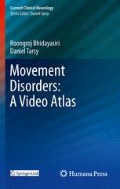Abstract
Deep brain stimulation (DBS) is currently the surgical treatment of choice for patients with intermediate or advanced Parkinson’s disease (PD) who are experiencing levodopa-related motor complications such as motor fluctuations, dyskinesias, and dystonias (see Chap. 5) which can no longer be successfully managed with antiparkinson medications. In double-blind trials, subthalamic (STN) and globus pallidus (GPi) DBS have been found to be approximately equally effective for reducing levodopa response fluctuations and improving dyskinesias in patients with advanced PD. STN-DBS allows for the dose of antiparkinson medications to be reduced, while following GPi-DBS, a direct antidyskinetic effect of DBS is achieved, but levodopa must be continued to maintain antiparkinson effects.
This chapter contains a video segment which can be found at the URL: https://doi.org/10.1007/978-1-60327-426-5_14
Access this chapter
Tax calculation will be finalised at checkout
Purchases are for personal use only
References
Deuschl G, Schade-Brittinger C, Krack P, et al. A randomized trial of deep-brain stimulation for Parkinson’s disease. N Engl J Med. 2006;355:896–908.
Weaver F, Follett K, Stern M, et al. Bilateral deep brain stimulation vs best medical therapy for patients with advanced Parkinson disease. JAMA. 2009;301:63–73.
Follett K, Weaver FM, Stern M, et al. Pallidal versus subthalamic deep-brain stimulation for Parkinson’s disease. N Engl J Med. 2010;362:2077–91.
Author information
Authors and Affiliations
Electronic Supplementary material
PD treated w. DBS.mp4 (MP4 32,800KB)
Clip 1: 12 h off levodopa, with DBS off, there is severe akinesia of arms in fixed elevated position, marked facial masking, and jaw-opening dystonia. Rapid finger tapping in left hand and toe tapping in both feet are hypokinetic. Clip 2: 90 min after levodopa, with DBS on, facial masking persists but without jaw dystonia and elevation of arms. Rapid finger tapping in left hand is improved, and toe tapping is still hypokinetic. Gait is shuffling without armswing. Clip 3: on another day, while on levodopa and with DBS on, facial expression and voice are normal, gait is brisk with normal armswing, and rapid finger and hand movements are normal.
Rights and permissions
Copyright information
© 2012 Springer Science+Business Media New York
About this chapter
Cite this chapter
Bhidayasiri, R., Tarsy, D. (2012). Parkinson’s Disease Treated with Deep Brain Stimulation. In: Movement Disorders: A Video Atlas. Current Clinical Neurology. Humana, Totowa, NJ. https://doi.org/10.1007/978-1-60327-426-5_14
Download citation
DOI: https://doi.org/10.1007/978-1-60327-426-5_14
Published:
Publisher Name: Humana, Totowa, NJ
Print ISBN: 978-1-60327-425-8
Online ISBN: 978-1-60327-426-5
eBook Packages: MedicineMedicine (R0)

